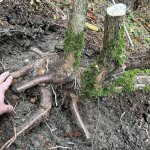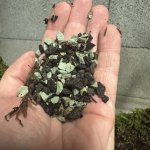Hey all! I need some advice and help. I am still unsuccessful with collecting Hawthorns. I tried few times. Best one lived for two years but eventually died. Many folks here on the forum wrote that it is really easy for them to collect hawthorns. I am successful with other spiecies but hawthorns are nightmare for me. In my area hawthorns have very big strong roots and usually even bigger tap root with minimal feeder roots close to the trunk. I potted them in mix of zeolite, perlite and black bag them. They sprouted, but every time eventually died.
I think, these points could be my reasons why they did not survived:
- I used too small particle sizes ( 3-6mm) causing too much moisture (and springs here could be really wet)
- I had not kept them long enough in black bag
- some returning freezing temperatures after collecting
What options I think I could improve - here is wellcomed any of your tips and tricks:
- to put collected tree to the garden for year or two instead of potting it (is so, use garden soil, or dig a hole and put tree to the garden with soil mix like for yamadori?)
- if potting I will try bigger particle sizes this time - I bought lava (6-12mm), zeolite (4-8mm), spagnum moss, pine bark (5-12mm)
- black bag tree and put it into my basement for month or so because of early spring freezings. (Temperature in basement is in early spring is around 10 Celcius, but very little light from small window)
- to use rooting stimulator on big wounds of cutted roots?
- try to collect in autumn istead of spring?
What do you think is best to try? Maybe somebody from Central Europe with his exact steps?
Hawthorn here are really like weed, so do not be angry with me that I destroyed few trees till now
I think, these points could be my reasons why they did not survived:
- I used too small particle sizes ( 3-6mm) causing too much moisture (and springs here could be really wet)
- I had not kept them long enough in black bag
- some returning freezing temperatures after collecting
What options I think I could improve - here is wellcomed any of your tips and tricks:
- to put collected tree to the garden for year or two instead of potting it (is so, use garden soil, or dig a hole and put tree to the garden with soil mix like for yamadori?)
- if potting I will try bigger particle sizes this time - I bought lava (6-12mm), zeolite (4-8mm), spagnum moss, pine bark (5-12mm)
- black bag tree and put it into my basement for month or so because of early spring freezings. (Temperature in basement is in early spring is around 10 Celcius, but very little light from small window)
- to use rooting stimulator on big wounds of cutted roots?
- try to collect in autumn istead of spring?
What do you think is best to try? Maybe somebody from Central Europe with his exact steps?
Hawthorn here are really like weed, so do not be angry with me that I destroyed few trees till now










